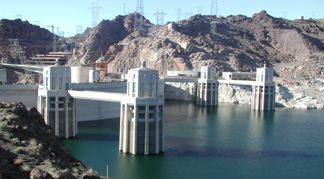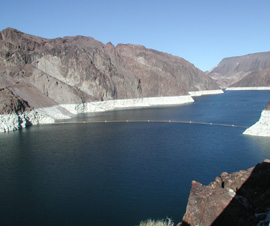Colorado River: Drought and Deadlines
Colorado River Water Users Association conferees hear Interior Secretary make demands of California to reduce its use of Colorado River water.
LeRoy W. Hooton, Jr.
|
Interior Secretary Gale Norton, making her first appearance before the Colorado River water users, gave California a stern warning. "If the California entities do not sign the Quantification Settlement Agreement (QSA), surplus water to Southern California will be automatically suspended in 2003," said Secretary Norton to a packed house. This warning could mean that cities in populous southern California could lose as much as one-half the water they normally receive from the Colorado River. Secretary Norton said that it's possible that there will be actual reductions in Colorado River aqueducts in January if the QSA is not signed by December 31, 2002.
Using a gaming metaphor, in this gaming Mecca, she noted that Interior and the California entities were in a high stakes card game and Interior was laying its cards on the table to show it was not bluffing. "Our common future is shaped by record drought and growth within the basin." said Secretary Norton. "These factors are heralding in a new era of limits on Colorado River water usage."
Two years ago, Secretary Bruce Babbitt and the seven Colorado Basin states entered into an agreement called the 4.4 Plan. Under the Plan California entities had to reduce their water usage by approximately 600,000 acre-feet over a 15-year period. On an interim basis California was granted use of Colorado River surplus water, conditional upon meeting certain milestones.
The QSA is one of the means for California to reduce it use of Colorado River water from over 5 million acre-feet (MAF) to its entitled 4.4 MAF apportionment under the 1923 Colorado River Compact and subsequent 4.4 Plan. Agricultural interests owns 3.85 MAF of California's share of 4.4 MAF; therefore water transfers from agriculture use to municipal use is viewed as a critical means of both reducing water usage and meeting California's urban growth demands. The QSA would allow the transfer of up to 400,000 acre-feet of agriculture water from the Imperial Irrigation District (IID) to San Diego for municipal use. Conservation measures include lining canals and improved agricultural practices, which includes crop rotation and fallowing farmlands would provide the water savings. Two weeks ago, after years of negotiations, the IID board of directors voted against the transfer. Among other things, the Salton Sea was a major sticking point. The inland sea is becoming more saline, creating a threat to the lake's fisheries and migrating birds. Estimates as high as $2 billion will be necessary to control the lake's water quality.
"The principle issue of the 4.4 Plan negotiations was how to achieve certainly that California would actually reduce its overuse from the Colorado River," said Secretary Norton. Failure to approve OSA has put the 4.4 Plan in jeopardy according to Secretary Norton, "What's not changing is our commitment to honor compacts, decrees and agreements -- otherwise the legal foundation upon which the river is administered will be at risk."
Andy Horne, IDD Director, told the assembled water users that the QSA deal has changed over the past 5-years and was no longer recognizable. The costs have increased to IID as well. The costs for environmental mitigation, social impacts, current debt and implementation of QSA are now over $200 million with no guarantee that it will work.
California's municipal users are the most at risk if there is a hard landing to meet the 4.4 Plan. "California's deficit is now $21 billion going onto $30 billion. The state can't take another economic hit," said MWD's Dennis Underwood. "So if you take 600,000 acre-feet of water from California's urban area there is going to be some impact." He noted that southern California's population is adding one-third the population of Las Vegas every year. The population is expected to reach 50 million by 2020 -2030.
The shortage of water was further emphasized when Secretary Norton and Secretary of State Colin Powell denied Mexico's request for additional water for the Mexican Delta. "As we explained to our friends, we do not have extra water to send across the border." At the conclusion of her speech Secretary Norton took no questions from the audience.
Bureau of Reclamation Commissioner John Keys backed his boss by reminding the audience about the new era of limits. "This is new for all of us. We have never in the states been as close to full utilization of our apportionments of water out of the river as we are now. The current drought even magnifies that impact that we're going into."
The drought in the Colorado River Basin is severe. The total water produced in 2002 was only 25 percent of normal. Overall system storage declined by 8.5 MAF -- the largest one-year drop on record.
|
Lake Powell has declined about 80 feet below its pool level. It's expected to drop another 10-feet by spring. The level in Lake Mead determines the amount of surplus water that will be available to the Lower Basin States. It is currently at an elevation of 1153 feet. The level is expected to drop 15-feet more to an elevation of 1135 feet by next fall. "The good news," said Commission Keys, "is after four years of drought, we still have water in the bank."
Depending on the winter precipitation and if California meets its 4.4 Plan milestones and interim guidelines, up to 600,000 acre-feet of surplus water can be made available to California, Arizona and Nevada. However, if the drought continues and the elevation of Lake Mead goes below 1145 feet, the amount of surplus water available in 2004 would be reduced to 250,000 acre-feet.
QSA negotiations are expected to continue and there was hope expressed that it will be signed before the December 31 deadline. Whether this milestone is met or not, drought, growth and environmental issues will continue to plague Colorado River Compact users. It is interesting to note the conflicts over water in the West continue as this water short region of the United States struggles to meet the challenges of supplying growing demands for water.
For additional related links visit-
http://www.slcclassic.com/utilities/
http://www.slcclassic.com/utilities/NewsEvents/news12192001.htm
http://www.slcclassic.com/utilities/news03162001.htm
http://www.slcclassic.com/utilities/NewsEvents/news121800.htm
http://www.slcclassic.com/utilities/NewsEvents/news10102000.htm

